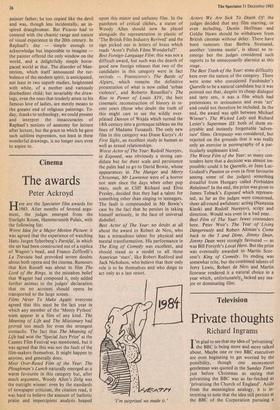Art
Favoured
John McEwen
Drawings by Raphael
(British Museum till 5 January 1984)
wG With wonderful indulgence and
generosity heaven sometimes showers upon a single person from its rich and inexhaustible treasures all the favours and precious gifts that are usually shared, over the years, among a great many people. This was clearly the case with Raphael San- zio of Urbino, an artist at talented as he was gracious, who was endowed by nature with the goodness and modesty to be found in all those exceptional men whose gentle humanity is enhanced by an affable and pleasing manner, expressing itself in courteous behaviour at all times and towards all persons.' So Vasari begins the chapter on Raphael in his famous Lives of the Artists; and when one has seen the ex- hibition at the British Museum these words, apparently so humdrum in their eulogistic way, assume the magnificence of their first intention, because they really are specific to Raphael alone among artists, even after all these years.
1983 marks the 500th anniversary of Raphael's birth and it seems only proper, therefore, to conclude this year's run of art columns with the climax of the first major exhibition of his drawings to have been held in this country since 1836. There are 170 firm attributions on view, with a further 30
borderline cases and School examples, this total representing the bringing together for the first time of all (with only three excep- tions) the drawings in English collections principally those of the British Museum, the Ashmolean, Chatsworth and the Royal Library at Windsor Castle. Raphael's style in his final and Roman period dominated European academic taste and teaching for the following three centuries, and it is to the collecting of two painters — Sir Peter Lely and, particularly, Sir Thomas Lawrence — that we owe such a wealth of his work. Half of the Chatsworth Collection derives from Lely's and almost all the Ashmolean and half the British Museum Collections from Lawrence's.
Raphael's father was Giovanni Santi, a minor painter attached to the Court of Ur- bino. Vasari tells us that Giovanni found a place for his son in Perugino's famous studio when he could teach him nothing more himself. As Giovanni died in 1494, it seems that Raphael must have become an assistant to Perugino no later than the age of 11; and a reference to him as 'magister' in the contract of 10 December 1500 for the altarpiece of the 'Coronation of St Nicholas of Tolentino' (a study of some hands related to this is No. 11 in the show) proves that by the age of 17 he had already achiev- ed the status of an independent master.
Art historically Raphael is usually paired as the contemporary opposite of Michelangelo, but this is founded on dif- ference of temperament more than style. Michelangelo was a loner, with no relevant tutor or pupils; Raphael was his sociable opposite — in the way he formed his art from the diligent imitation of the work of other artists, as much as in the gre- gariousness of his life. Reynolds summed up the modernity (still prevailing) of Raphael's magpie method, in his Sixth Discourse: 'it is from his having taken so many models, that he became himself a model for all succeeding painters; always imitating, and always original'. Perugino was only the first of such models — later he assimilated the styles and discoveries of Leonardo, Durer, Titian and Michelangelo himself, who was rightly outraged when Bramante gave his greatest rival a sneak preview of the Sistine Chapel.
Picasso is correctly considered Raphael's truest — and perhaps only worthy modern equivalent. He too was an infant prodigy taught at first by a less gifted painter father; he too copied like the devil and was, though less incidentally, an in- spired draughtsman. But Picasso had to contend with the chaotic range and nature of visual experience in the 20th century. In Raphael's day — simple enough to acknowledge but impossible to imagine the painter offered the only window on the world, and a delightfully simple horse- paced world at that. The disorder of Man- nerism, which itself announced the tur- bulence of the modern spirit, is anticipated, not least in two superb studies, heightened with white, of a mother and variously disobedient child; but invariably the draw- ings, even the ones that tenderly attest to his famous love of ladies, are merely means to the greater end of religious paintings. To- day, thanks to technology, we could present and interpret the innaccuracies of Raphael's notions of anatomy for lecture after lecture, but the grace to which he gave such sublime expression, not least in these wonderful drawings, is no longer ours even to aspire to.















































 Previous page
Previous page